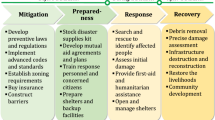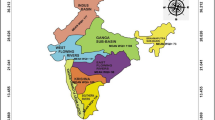Abstract
Landslide prediction is critical for the early warning of a landslide occurrence. Existing stepwise landslide displacement prediction methods are mostly data-driven approaches. However, these models are vulnerable to overfitting, and the low-dimensional numerical features with high numerical volatility prevent them from precisely quantifying the rapid increase in daily displacement in the acceleration phase. Therefore, we propose a semantic information-driven stepwise landslide displacement prediction model comprising an identifier in the displacement phase and a predictor in the acceleration phase. First, the raw landslide monitoring data are converted into text-based semantic information and the semantic features are fused. Subsequently, based on the daily displacement and velocity, we propose a sliding window phase division algorithm to divide the stepwise landslide phase into stationary and acceleration phases. Finally, the landslide displacement phase is identified, and the displacement during the acceleration phase is predicted. The experimental results of the model on the Xinpu and Qingshi landslides in Chongqing, China, show that the proposed model exploits the derived semantic information to identify the landslide acceleration phase qualitatively, and predict the daily displacement of the acceleration phase quantitatively. The proposed model provides a valuable reference for the early warning of stepwise landslides.

















Similar content being viewed by others
Availability of data and material
Not applicable.
References
Aggarwal, A., Alshehri, M., Kumar, M., Alfarraj, O., Sharma, P., & Pardasani, K. R. (2020). Landslide data analysis using various time-series forecasting models. Computers & Electrical Engineering, 88, 106858.
Cai, Z., Xu, W., Meng, Y., Shi, C., & Wang, R. (2016). Prediction of landslide displacement based on galssvm with multiple factors. Bulletin of Engineering Geology and the Environment, 75(2), 637–646. https://doi.org/10.1007/s10064-015-0804-z
Chen, H., & Zeng, Z. (2013). Deformation prediction of landslide based on improved back-propagation neural network. Cognitive Computation, 5(1), 56–62. https://doi.org/10.1007/s12559-012-9148-1
Church, K. W. (2017). Word2vec. Natural Language Engineering, 23(1), 155–162.
Du, J., Yin, K., & Chai, B. (2009). Study of displacement prediction model of landslide based on response analysis of inducing factors. Chinese Journal of Rock Mechanics and Engineering, 28(9), 1783–1789.
Ge, Q., Sun, H., Liu, Z., Yang, B., Lacasse, S., & Nadim, F. (2021). A novel approach for displacement interval forecasting of landslides with step-like displacement pattern. Georisk: Assessment and Management of Risk for Engineered Systems and Geohazards, 16(9), 1–15. https://doi.org/10.1080/17499518.2021.1892769
Gers, F. A., Schmidhuber, J., & Cummins, F. (2000). Learning to forget: Continual prediction with lstm. Neural Computation, 12(10), 2451–2471. https://doi.org/10.1162/089976600300015015
Goldberg, Y., & Levy, O. (2014). word2vec explained: Deriving mikolov et al.’s negative-sampling word-embedding method. arXiv preprint arXiv:14023722
Guo, Z., Chen, L., Gui, L., Du, J., Yin, K., & Do, H. M. (2020). Landslide displacement prediction based on variational mode decomposition and wa-gwo-bp model. Landslides, 17(3), 567–583. https://doi.org/10.1007/s10346-019-01314-4
Han, H., Shi, B., & Zhang, L. (2021). Prediction of landslide sharp increase displacement by svm with considering hysteresis of groundwater change. Engineering Geology, 280, 105876.
Honglie, S. (2000). Climate resources science. Chinese resources science encyclopedia (pp. 468–532). China Petroleum Press.
Huber, P. J. (1992). Robust estimation of a location parameter. Breakthroughs in statistics (pp. 492–518). Springer.
Intrieri, E., Carlà, T., & Gigli, G. (2019). Forecasting the time of failure of landslides at slope-scale: A literature review. Earth-Science Reviews, 193, 333–349. https://doi.org/10.1016/j.earscirev.2019.03.019
Jiang, H., Li, Y., Zhou, C., Hong, H., Glade, T., & Yin, K. (2020). Landslide displacement prediction combining lstm and svr algorithms: A case study of shengjibao landslide from the three gorges reservoir area. Applied Sciences, 10(21), 7830. https://doi.org/10.3390/app10217830
Li, L., Wu, Y., Miao, F., Xue, Y., Zhang, L., Liao, K., Teng, W., & Shi, H. (2019). Displacement interval prediction method for step-like landslides considering deformation state dynamic switching. Journal of the Korean Geotechnical Society, 2, 248–248.
Li, X., & Kong, J. (2014). Application of ga-svm method with parameter optimization for landslide development prediction. Natural Hazards and Earth System Sciences, 14(3), 525–533.
Lin, T. Y., Goyal, P., Girshick, R., He, K., & Dollár, P. (2017). Focal loss for dense object detection. In: Proceedings of the IEEE international conference on computer vision, pp 2980–2988.
Liu, Y., Xu, C., Huang, B., Ren, X., Liu, C., Hu, B., & Chen, Z. (2020). Landslide displacement prediction based on multi-source data fusion and sensitivity states. Engineering Geology, 271, 105608. https://doi.org/10.1016/j.enggeo.2020.105608
Loshchilov, I., & Hutter, F. (2016). Sgdr: Stochastic gradient descent with warm restarts. arXiv preprint arXiv:160803983
Novaković, J. D., Veljović, A., Ilić, S. S., Papić, Ž, & Milica, T. (2017). Evaluation of classification models in machine learning. Theory and Applications of Mathematics & Computer Science, 7(1), 39–46.
Ren, F., Wu, X., Zhang, K., & Niu, R. (2015). Application of wavelet analysis and a particle swarm-optimized support vector machine to predict the displacement of the shuping landslide in the three gorges, China. Environment and Earth Science, 73(8), 4791–4804. https://doi.org/10.1007/s12665-014-3764-x
Sutskeve, I., Martens, J., Dahl, G., & Hinton, G. (2013). On the importance of initialization and momentum in deep learning. International conference on machine learning (pp. 1139–1147). PMLR.
Tang, H., Wasowski, J., & Juang, C. H. (2019). Geohazards in the three gorges reservoir area, China-lessons learned from decades of research. Engineering Geology, 261, 105267. https://doi.org/10.1016/j.enggeo.2019.105267
Tsai, Y. H. H., Bai, S., Yamada, M., Morency, L. P., & Salakhutdinov, R. (2019). Transformer dissection: A unified understanding of transformer’s attention via the lens of kernel. arXiv preprint arXiv:190811775
Vaswani, A., Shazeer, N., Parmar, N., Uszkoreit, J., Jones, L., Gomez, A. N., Kaiser, L., & Polosukhin, I. (2017). Attention is all you need. arXiv preprint arXiv:170603762
Wang, J., Wang, Z., Zhang, D., & Yan, J. (2017). Combining knowledge with deep convolutional neural networks for short text classification. In: IJCAI, vol 350.
Willmott, C. J., & Matsuura, K. (2005). Advantages of the mean absolute error (MAE) over the root mean square error (RMSE) in assessing average model performance. Climate Research, 30(1), 79–82.
Wu, L., Li, S., Huang, R., & Xu, Q. (2020). A new grey prediction model and its application to predicting landslide displacement. Applied Soft Computing, 95, 106543. https://doi.org/10.1016/j.asoc.2020.106543
Wu, X., Chen, X., Zhan, F. B., & Hong, S. (2015). Global research trends in landslides during 1991–2014: A bibliometric analysis. Landslides, 12(6), 1215–1226. https://doi.org/10.1007/s10346-015-0624-z
Xu, Q., Peng, D., Zhang, S., Zhu, X., He, C., Qi, X., Zhao, K., Xiu, D., & Ju, N. (2020). Successful implementations of a real-time and intelligent early warning system for loess landslides on the Heifangtai terrace, China. Engineering Geology, 278, 105817. https://doi.org/10.1016/j.enggeo.2020.105817
Xu, S., & Niu, R. (2018). Displacement prediction of Baijiabao landslide based on empirical mode decomposition and long short-term memory neural network in three gorges area, China. Computers & Geosciences, 111, 87–96. https://doi.org/10.1016/j.cageo.2017.10.013
Yang, B., Yin, K., Lacasse, S., & Liu, Z. (2019). Time series analysis and long short-term memory neural network to predict landslide displacement. Landslides, 16(4), 677–694. https://doi.org/10.1007/s10346-018-01127-x
Zhou, C., Yin, K., Cao, Y., Intrieri, E., Ahmed, B., & Catani, F. (2018). Displacement prediction of step-like landslide by applying a novel kernel extreme learning machine method. Landslides, 15(11), 2211–2225. https://doi.org/10.1007/s10346-018-1022-0
Author information
Authors and Affiliations
Corresponding author
Ethics declarations
Conflict of interest
The authors declare no competing interests.
Additional information
Publisher's Note
Springer Nature remains neutral with regard to jurisdictional claims in published maps and institutional affiliations.
Rights and permissions
Springer Nature or its licensor holds exclusive rights to this article under a publishing agreement with the author(s) or other rightsholder(s); author self-archiving of the accepted manuscript version of this article is solely governed by the terms of such publishing agreement and applicable law.
About this article
Cite this article
Tang, F., Tang, T., Zhu, H. et al. A semantic information-driven stepwise landslide displacement prediction model. Environ Monit Assess 194, 836 (2022). https://doi.org/10.1007/s10661-022-10417-w
Received:
Accepted:
Published:
DOI: https://doi.org/10.1007/s10661-022-10417-w




